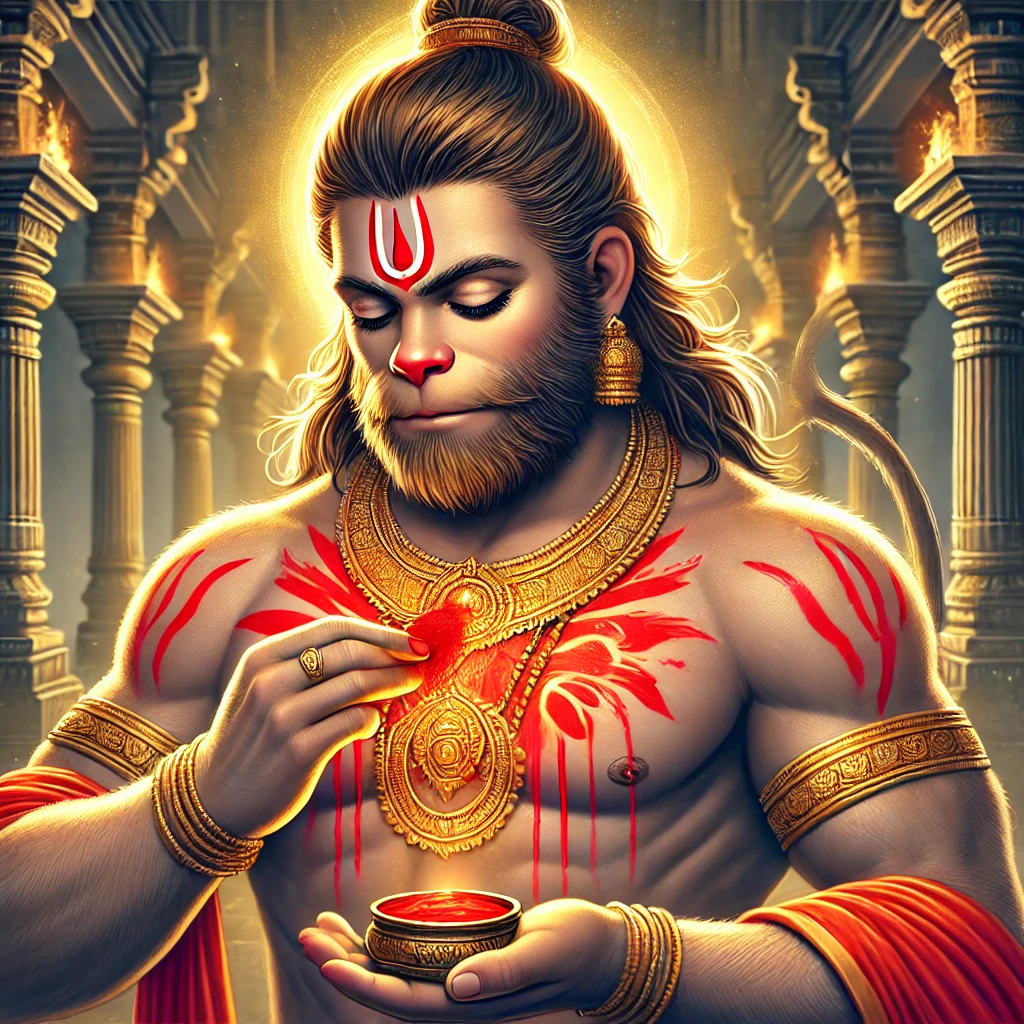Table of Contents
Introduction
Welcome to Bedesii.com, your trusted source for spiritual insights and uplifting stories that bring meaning to daily life. Today, we’re diving into the captivating story behind the vibrant red color of Lord Hanuman’s idol—a unique symbol of love, devotion, and resilience that has inspired generations of devotees.
In this blog, we’ll uncover the origin of Hanuman’s red form, exploring how this colorful tradition began and what it represents in Hindu spirituality. From the heartwarming legend that sparked the custom to the cultural and spiritual meanings woven into the red sindoor, we’ll journey through the many layers of symbolism that make this deity’s image so powerful.
Whether you’re new to Hanuman’s story or a lifelong devotee, this article aims to deepen your understanding of his significance and inspire you with his legacy of unwavering faith and courage. Join us as we explore the story behind Hanuman’s red idol—a story that continues to remind us of the power of devotion and the blessings it brings.
The Significance of Hanuman Red Idol
Lord Hanuman, a beloved figure in Hindu mythology, is celebrated not only for his incredible strength and bravery but also for his unshakable devotion to Lord Rama. Among his many depictions, the vibrant red color of Hanuman’s idol has captivated devotees for centuries. This article explores the fascinating story behind Hanuman’s red idol, its cultural roots, and the profound spiritual symbolism it embodies.
The Origin of the Red Color

The story of Hanuman’s red color originates from a moving episode in the Ramayana. One day, as Hanuman observed Goddess Sita applying sindoor (vermilion) on her forehead, he asked her why she performed this ritual. Sita explained that sindoor symbolized her love and devotion to Rama, ensuring his well-being and protection.
Inspired, Hanuman decided to express his own devotion in a grand manner. He covered his entire body with sindoor, believing that if a small amount benefited Rama, then covering himself would further show his loyalty. When Rama saw Hanuman’s vivid appearance, he was deeply touched by his devotee’s selfless act. Moved by this pure gesture, Lord Rama blessed Hanuman, declaring that any devotee who honored him with sindoor would receive special blessings and protection from their troubles.
This legend marked the beginning of the tradition of using sindoor in Hanuman worship, with red symbolizing both devotion and a heartfelt connection with the divine.
Cultural Implications
In Indian culture, the color red holds rich symbolism. It represents power, passion, protection, and sacrifice, and is frequently associated with auspiciousness and purity. The bold red color of Hanuman’s idol embodies these meanings, standing as a reminder of his fiery spirit and unyielding devotion. The sight of the red idol often fills devotees with a sense of courage, as Hanuman himself overcame countless challenges through his unwavering faith and strength.
For devotees, worshipping Hanuman in this form is seen as a way to invite resilience into their lives, drawing from his boundless energy and steadfast loyalty. His red idol thus serves as a symbol of inner strength and a call to face life’s obstacles with fortitude.
Spiritual Symbolism
Beyond its cultural relevance, Hanuman’s red idol has profound spiritual symbolism. The act of applying sindoor represents a devotee’s dedication and commitment to their chosen deity. For many, smearing sindoor on Hanuman’s idol during prayers is a deeply personal expression of devotion and reverence. This practice is believed to draw blessings from Hanuman, enhancing one’s courage and protection against negative forces.
Spiritually, red is often linked to the root chakra (Muladhara), which stands for stability, grounding, and survival. By connecting with Hanuman through his red form, devotees strengthen their spiritual foundation, seeking stability and a balanced perspective as they navigate life’s challenges.
Historical Context
The tradition of depicting Hanuman as a red idol has endured for centuries, especially in Northern and Western India. Many Hanuman temples feature these distinctive idols, becoming spiritual centers for devotees seeking solace and courage. Over time, this vibrant depiction of Hanuman has inspired artists, architects, and devotees alike, finding representation in various forms of art, including ancient temple carvings and paintings that celebrate his divine virtues.
Hanuman’s red image has evolved into a cultural icon, rooted deeply in the religious and spiritual practices of India. These idols not only convey his devotion to Lord Rama but also highlight his role as a protector and divine aid to those in distress.
Insights into Lord Hanuman
Here are a few intriguing facts about Lord Hanuman that deepen the understanding of his unique legacy:
- Many Names and Titles: Known by names like Anjaneya (son of Anjana), Maruti (son of the wind), and Bajrangbali (the mighty one), each name reflects different aspects of his personality and divine heritage.
- The Immortal Protector: Hanuman is revered as a Chiranjeevi (immortal being), blessed with eternal life until the end of time, symbolizing his everlasting role as a protector of the righteous.
- The Embodiment of Bhakti: Hanuman is often considered the supreme example of Bhakti (devotion). His loyalty to Lord Rama has made him a central figure in bhakti traditions.
- Defender Against Evil: Many devotees recite the Hanuman Chalisa or other hymns dedicated to him, believing that his blessings guard them from negative influences and evil forces.
- Celebrated Across Festivals: Hanuman Jayanti, a festival celebrating his birth, is a major occasion marked by special prayers, offerings, and rituals, with festivities varying across regions.
Conclusion
The significance of Lord Hanuman’s red idol serves as a powerful reminder of the profound values of love, devotion, and inner strength. For devotees, the act of offering sindoor to Hanuman’s red form is a prayer for his divine protection and blessings. His vibrant color and timeless story capture the essence of unwavering faith, inspiring devotees to face life’s trials with courage, as he did.
By exploring this sacred symbol, we uncover a glimpse of the powerful spiritual and cultural heritage that Lord Hanuman represents in Hinduism, forever echoing the ideals of true devotion and resilience.
Important Links
Hanuman Chalisa in Hindi | Hanuman Chalisa in Kannada |Hanuman Chalisa in Bengali | Bajrang Baan in English | Hanuman Ashtak | Hanuman Chalisa in Assamese
FAQ
Why is sindoor offered to Hanuman?
Sindoor is offered to Lord Hanuman as a symbol of devotion and love. The tradition stems from an episode in the Ramayana where Hanuman saw Goddess Sita applying sindoor on her forehead as a mark of her love for Lord Rama. In a display of his own devotion, Hanuman smeared his entire body with sindoor, which led to the belief that worshipping him with sindoor would alleviate devotees’ troubles and bring blessings.
Can we apply kumkum to Hanuman?
Yes, kumkum can be applied to Lord Hanuman. While sindoor is traditionally used, kumkum is also considered auspicious and can be offered during prayers. It symbolizes purity and devotion, making it acceptable for worship.
What is the name of Hanuman’s Sindur?
Hanuman’s sindoor does not have a specific name but is commonly referred to simply as “sindoor” or “vermilion.” It represents his devotion and is associated with the red color that signifies strength and auspiciousness in Hindu culture.
What do you mix with Hanuman Sindoor?
Hanuman’s sindoor is often mixed with oil before application. This mixture helps in maintaining the consistency of the sindoor and enhances its application during rituals. The combination of sindoor and oil is believed to be favored by Hanuman himself.
Can girls offer prasad to Hanuman ji?
Yes, girls can offer prasad to Lord Hanuman. There are no restrictions based on gender when it comes to worshipping Hanuman or offering prasad. Devotion and sincerity are what matter most in Hindu worship.
Which oil does Hanuman like?
While there isn’t a specific oil mentioned that Lord Hanuman prefers, many devotees use sesame oil (til oil) or Chameli oil when preparing offerings that include sindoor. These oils are commonly used in various Hindu rituals and are considered pure.
How to keep Hanuman happy?
To keep Lord Hanuman happy, devotees can:
1. Recite the Hanuman Chalisa regularly.
2. Offer sindoor and sweets like laddus during prayers.
3. Engage in selfless service (seva) and help others.
4. Maintain a pure heart and mind while praying.
Can a girl wear a Hanuman locket during periods?
Yes, a girl can wear a Hanuman locket during her periods. There are no specific restrictions regarding wearing religious symbols or lockets during menstruation in Hinduism. It is a personal choice based on comfort and belief.
Can a woman read Bajrang Baan?
Yes, women can read the Bajrang Baan, which is a powerful hymn dedicated to Lord Hanuman. There are no restrictions based on gender for reciting this prayer; it is open to all devotees seeking protection and strength.
What is Hanuman Sindoor made of?
Hanuman Sindoor is primarily made from vermilion (sindoor), which consists of natural pigments mixed with binders. Some devotees may also mix it with sesame oil for application during rituals.
Can girls offer Sindoor to Hanuman?
Yes, girls can offer sindoor to Lord Hanuman without any restrictions. Offering sindoor as part of worship reflects devotion regardless of gender.







